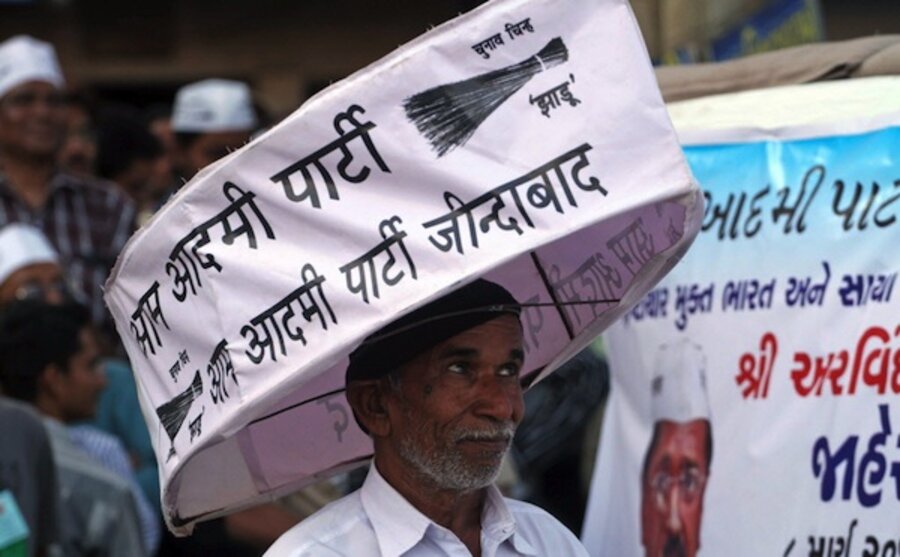India's upstart party preaches anticorruption. What else does it stand for?
Loading...
| New Delhi
When Ashok Aggarwal yesterday quit India's newest political party, which he had helped set up in November 2012, he took a parting swipe at his erstwhile allies.
“The movement seems to have become directionless, causing doubts in the minds of people and even in people like me,” he wrote in his resignation letter. The vision of the Aam Aadmi Party (AAP), or Common Man Party, founded on a staunch anticorruption platform, has “taken a back seat” to personal political ambitions, he charged.
Mr. Aggarwal’s resignation showcases some of the difficulties the AAP faces in trying to channel popular frustration over political graft into success at India's upcoming national polls. The parliamentary elections in April and May are widely considered the most important in years and, given its surge in support, the AAP is expected to be in whichever coalition government emerges. But its slate of candidates is a grab bag of contradictions – leaving open the possibility that its pitch to voters may be undone by its differences.
“It is for sure that the AAP will be the wild card in the upcoming elections,” says Delhi-based political analyst Neerja Chowdhury. Opinion polls put the party at between 6 percent and 14 percent.
In December, the AAP trounced the ruling Congress Party in state elections in Delhi. Its surprise victory led to the formation of an AAP administration that resigned in February after the defeat of an anticorruption bill.
Regardless, the party has seen a flood of applicants from politicians of varying backgrounds seeking to run under its banner. In some cases, they are even former adversaries.
In Mumbai, the two AAP candidates standing for the Lok Sabha, India's lower house of parliament, are Meera Sanyal and Medha Patkar. Two decades ago Ms. Sanyal led a bank that was financing a power station in Mumbai for US energy firm Enron. Ms. Patkar led protests against it, accusing Enron, which later went bankrupt, of human rights and environmental violations. Since then, the women have been enemies. Now they’re both standing for the same party.
Still, for India such an umbrella party has strong precedents, says Ms. Chowdhury. “The Congress [Party] under Jawaharlal Nehru was a party that had people from all ideologies. Sixty years ago, they were united under the Congress banner because they believed in the idea of building a new India."
Similarly, the political forces joining the AAP have one clear goal – tackling India's endemic corruption. It's a popular message: seven in ten Indians are dissatisfied with how things are going in their country, according to a poll released last month by Pew Research Center. Thirty percent of the 543 sitting lawmakers in the Lok Sabha have criminal charges against them, according to the Delhi-based Association for Democratic Reforms.
Public discord among leaders
The AAP has run into problems over its divergent public statements. In January, senior AAP leader Prashant Bhushan said he supports a referendum in the divided Jammu and Kashmir state on the role of the Indian Army in its internal security. Two days later, party chief Arvind Kejriwal issued a clarification on what remains a controversial subject in India. "We don't agree with what Prashant Bhushan said about Kashmir, it's his personal view," he said.
Despite its initial fumbling, the party's embrace of diverse candidates could pay off in the long run, says Shiv Visvanathan, a professor of public policy at the OP Jindal Global University in Haryana. “In front of the AAP, the Bharatiya Janata Party, which is likely to come to power, will look more and more authoritarian and homogeneous. And AAP will look like it is more representative of Indian democracy with divergent views,” he says.
As national elections draw closer, the AAP's leaders have tried to pull together their platform, including its policies on India's economy, which has slowed sharply in recent years.
Arun Kumar, a professor of economics at Jawaharlal Nehru University in Delhi and an advisor to the party, says that it has a "centrist" agenda. During its brief tenure in Delhi's local government, the party banned foreign-owned supermarket groups from operating there, but it has yet to spell out a national policy on issues such as foreign investment in mining and other industries.
For the 9.8 million potential voters who have joined the party through January, though, fighting corruption seems to be a platform in itself. “As long as you deal with corruption, it doesn’t matter whether you do it using right-wing policy or left-wing policy,” says Chowdhury.





